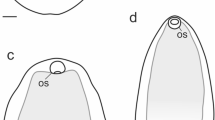Abstract
THE manner in which a Simulium larva fixes itself to rocks and water weeds in very rapid running water has hitherto been a matter of dispute among naturalists. Some have supposed that the so-called ‘posterior” sucker of a Simulium larva functions in the same way as does the sucker of a leech, and it is only recently that Tonnoir (Ann. Biol. Lacustre, 11, pp. 163–172; 1923), not finding any muscles inserted in the middle of the disc, doubted its utility as a true sucker and ascribed the ftunction of attachment to the hooks alone. Dr. Puri (Parasitology, 17, pp. 295–369; 1925), to whom we are indebted for a monograph, “On the Life-history and Structure of the Early Stages of Simuliidæ” (1925), has demonstrated the presence of fairly strong muscles connected with the centre of the disc, and he has observed “that they contract when the larva fixes itself by its posterior end.” But he further points out that “in spite of the presence of these muscles the larva cannot fix itself effectively without the further help of the sticky salivary secretion; a fact which may mean that the saliva helps to fill up the spaces between the hooks and thus to form a complete rim all round.”
Similar content being viewed by others
Author information
Authors and Affiliations
Rights and permissions
About this article
Cite this article
HORA, S. The Mechanism of the so-called ‘Posterior Sucker’ of a Simulium Larva. Nature 119, 599–600 (1927). https://doi.org/10.1038/119599b0
Issue Date:
DOI: https://doi.org/10.1038/119599b0
- Springer Nature Limited





